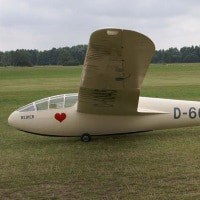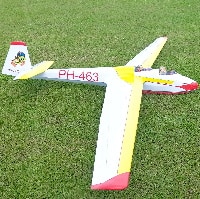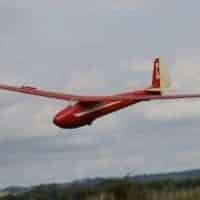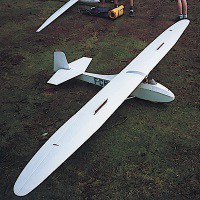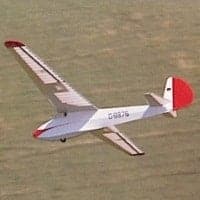Description
DFS Reiher
Even by today’s standards, the Reiher had a very modern fuselage nose contour. It had a faired-in landing skid. Dr. Slater recalled that when Slingsby saw the prototype he was so impressed that he incorporated Its form Into the designs of the Gull and Petrel. The ailerons of the production model were operated by pushrod. Cables had been used for the prototype. It had no external control surface operating horns. When the prototype’s flap was moved down 15 degrees the ailerons were also trimmed down by 8 degrees . The Reiher’s rigging and derigging was ultra-quick, as for the Weihe. The two wing-fuselage pins were inserted by moving one lever on each side. A single main pin was inserted vertically, from above through a hole in the top of the fuselage. All controls coupled automatically during rigging.
All this adds up to a great sailplane. Tests carried out in 1941 at Trebbin, the Reichsfliegerschule north of Berlin, showed that its performance was only exceeded by that of the Horten 4a and the Darmstadt D-30 “Cirrus”.
DFS Reiher Operational history
Despite the problems encountered at the Rhön competition with the Reiher prototype in 1937, Reitsch managed to fly into sixth place. In the process she set on 4 July 1937 a Germans women’s distance record of 349 km (161 mi) which stood until 1968. In 1938 the prototype, stiffened and heavier, was flown into first place by Wolfgang Späte in the same event and in 1939 the Reiher III won there in the hands of Erwin Kraft. Six Reiher competed in 1939, the 20th Rhön competition and the last before World War II.
No Reiher survived the war. In the 1990s the Wasserkuppe Old Timers Group built a careful replica which is now the museum there. A second reproduction Reiher III first flew in 2009.
Variants
Reiher I
Prototype D-11-95. Later, stiffened and heavier, it won the 1938 Rhön German national competition, flown by Wolfgang Späte.
Reiher II
Wing, fuselage and vertical tail revisions. Small series production.
Reiher III
Further improvements including stiffening, lightening and ballast provision. 1939 Rhön German national competition winner, flown by Erwin Kraft.
Specifications
General characteristics
Crew: One
Length: 7.76 m (25 ft 6 in)
Wingspan: 19.00 m (62 ft 4 in)
Height: 2.28 m (7 ft 6 in) [6]
Wing area: 19.36 m2 (208.4 sq ft)
Aspect ratio: 18.85
Airfoil: Göttingen 549 to 60% of span, Göttingen 676 outboard
Empty weight: 230 kg (507 lb)
Gross weight: 315 kg (694 lb)
Performance
Maximum speed: 200 km/h (124 mph; 108 kn)
Stall speed: 60 km/h (37 mph; 32 kn)
Maximum glide ratio: 33:1
Rate of sink: 0.50 m/s (98 ft/min)
Wing loading: 16.44 kg/m2 (3.37 lb/sq ft)

